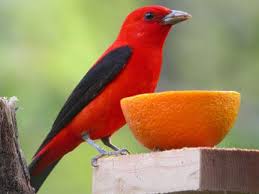by DJ Featherton
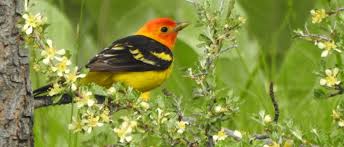
Even as a kid I’d get excited when my mother would exclaim, “Oh, look, there’s a Scarlet Tanager!” Always unmistakable in his brilliant bright-red with jet-black wings high in the treetops. There are three Tanagers common across the U.S.: the Scarlet, the Summer and the Western Tanager. Each has their own brilliant colors and their own breeding areas. This gives all backyard birders at least one fabulously beautiful Tanager to identify and attract to our feeders. North, south, east or west, there are Tanagers for everyone.
~ The Scarlet Tanager: The male Scarlet Tanager is bright-red with black wings. Usually, you have to keep an eye to the tops of the trees to catch a glimpse of this beauty, but the extra effort pays off. The female is a muted olive with darker wings. She is even harder to find up in the canopies. These song birds eat most any insect, and will sometimes eat a snail or earthworm on the ground. Berries and fruit are also part of their diet and good to include on your feeder to attract these guys. The Scarlet Tanagers range covers the eastern half of the U.S. and they migrate down into South America. Listen for a raspy, robin-like song, a distinctive chick-burr call, and then start your search. Frequently, a birder is first alerted to a bird by his song. Keep listening!
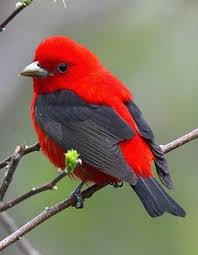
~ The Summer Tanager: The Summer Tanager is simply all red. No mask, no checks or stripes, all bright-red! In fact, this Tanager is said to be the only all red bird in North America. Eye catching? You bet! The female is a yellowish tan, and can be difficult to spot. The Summer Tanager’s range overlaps that of the Scarlet Tanager, but runs through the south all the way to California. They migrate into South America. Summer Tanagers feed on a variety of insects, but favor bees and wasps. Interestingly, they catch their prey in mid-air before bringing it back to the perch to be beaten to death against the tree. Hmm, bummer for the bees! Berries and fruit are also a big part of their diet and will help attract this beautiful bird to your feeder. As a song bird, you may recognize their pit-ti-tuck call before you spot the bright-red flash, high amid the green leaves. Don’t miss the Summer Tanager.
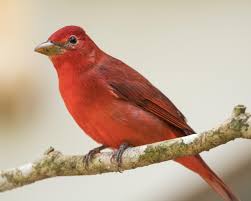
~ The Western Tanager: Just like the other Tanagers, The Western Tanager has his own spectacle. Who can miss the orange-red head, bright yellow body with black wings, back and tail? The female is a yellow-green with a small amount of black. They spend their time high in the western conifers dining on insects of all kinds. Fresh fruit will attract them to your feeder, and running water and a birdbath will be a great help as well. The Western Tanager’s range is from Northwestern Canada into the western third of the U.S. and well into Mexico and Central America. Every bird has his own special behavior and the Western Tanager is no exception. Seems the male does an odd tumbling act falling just past the female to show off his colors and impress. Though this didn’t work with my wife, birders have enjoyed this unusual spectacle performed by the Western Tanager..
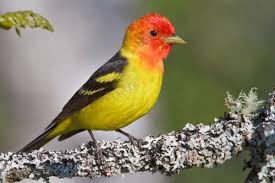
The ranges of these three Tanagers cover the entire U.S. in three distinct north, south, and western regions. The Cornell Lab gauges their population numbers as “low concern.” Yet, fragmentation of their environment and changes of climate will alter their ranges, and ultimately, their numbers. Backyard feeding by us 50 million birders is a bigger help than we can imagine. Today, however, we have Tanagers from coast to coast, and indeed, there are Tanagers for everyone.
